
Each orchard requires constant renewal. Trees grow old, lose yield, and from time to time they have to be replaced with new plantings.
What sort of apple to choose? New fruit tree should be fruitful, winter-hardy, resistant to diseases such as scab, and bringing delicious juicy fruits.
Without a doubt, apple variety VeteranThe photo and description of which is in our article has all these qualities.
What kind is it?
 Veteran refers for winter varieties apples with late ripening, which was bred in the All-Russian Scientific Research Institute for Breeding Fruit Crops of the Russian Academy of Agricultural Sciences.
Veteran refers for winter varieties apples with late ripening, which was bred in the All-Russian Scientific Research Institute for Breeding Fruit Crops of the Russian Academy of Agricultural Sciences.
This variety has been approved for cultivation in Central Black Earth Region of Russia and in 6 areas Belarus in 1989.
To the winter varieties of apple trees also belong: Lada, Cliff, Rennet Simirenko, Snowdrop and Aport.
Pollination
Apple Veteran is a self-fertile variety. It is pollinated by its own pollen, so it does not require cross-pollination.
This quality helps the fruit tree not to depend on weather conditions and the flight of bumblebees and bees, which allows it to give a stable crop.
Variety description Veteran
Consider separately the appearance of the apple and fruit.
Apple tree veteran possesses medium heightthat is, reaches no more than 3 meters high. Apple crown is different neat spherical shape.
For the bark of the branches and the tree trunk is characteristic brown. Young thin shoots are dark brown in color and slightly pubescent. On the fresh branches, lentils are present in the form of small strokes used for gas exchange. The buds are tightly pressed against the branches.
Grayish foliage has an ovoid shape with slightly wrapped edges, small petioles and short stipules. The leaf plate is wrinkled and faded, slightly serrated on the edges. The small flowers of the apple tree are painted in light pink tones.
 Variety apples Veteran is medium-sized fruits weighing up to 160 g In shape, they are slightly flattened, and closer to the tip of the conical.
Variety apples Veteran is medium-sized fruits weighing up to 160 g In shape, they are slightly flattened, and closer to the tip of the conical.
The peel of the fruit has a dense smooth structure, has a slight luster and is covered with a thin wax coating. Rare greyish dots peep through the skin.
The main color range of apples is yellow-golden. It is covered with a gentle blush of pink shades in the form of spots with fuzzy edges, strokes and specks.
Juicy fruit pulp has excellent sweet and sour taste. During a professional tasting, the Veteran's apples score was from 4.3 to 4.5 points on a 5-point scale.
| Composition | amount |
|---|---|
| Sahara | 9,5% |
| Titrated acids | 0,64% |
| Ascorbic acid | 17.5 mg per 100 g |
| Vitamin P | 307 mg per 100 g |
| Pectic substances | 10,9% |
Also such great varieties as Anis, Medunitsa, Molodezhny, Aromatic and Orlinka demonstrate excellent taste and benefit.
Harvesting apples Veteran can already in September. In cool conditions, the fruits retain all their qualities. until the end of winter and even a little longer.
In addition to fresh use, the fruit is suitable for preservation and other types of processing (jam, jam, jam, etc.).
A photo



Breeding history
Veteran grade was obtained at the Oryol fruit station a group of breeders N. G. Krasov, M. V. Mikheev and E. N. Sedova.
The apple tree was bred by sowing seeds obtained from the free pollination of a variety of American selection King in 1961.
After 8 years in 1969, the first apple tree bore the first fruits, and in 1972 it was ranked among the elite varieties.
Next, a new apple variety has passed state tests. Since 1989 allowed its cultivation in Russia.
Distribution region
 For the cultivation of fruit trees is very important indicator of winter hardiness, since severe winters are not uncommon in Russian latitudes.
For the cultivation of fruit trees is very important indicator of winter hardiness, since severe winters are not uncommon in Russian latitudes.
Apple Tree Veteran is a variety medium frost resistance. Besides Central Black Earth regionit grows well and bears fruit North-Western regions and in the south of Central Russia.
In other regions, cultivating the Veteran variety is fraught with the risk of freezing of the tree even in a normal winter, and in a severe one, the death of an apple tree is not excluded.
The variety is resistant to diseases such as //selo.guru/ptitsa/bolezni-p/gribkovye/parsha.html. This quality is important for veteran cultivation in areas high humidity, because scab most often in such conditions affects fruit trees.
Varieties are also resistant to scab: Malt Bagaevsky, Narodny, Altai Bagryanaya, Berkutovsky and Venyaminovsky.
Yield
Veteran variety is characteristic precocity and yield. Apple trees begin to bear fruit already on the 4th or 5th year.
From one tree at the age of 8 you can collect about 60 kg of juicy apples, and after 13 years old one apple tree is able to bring already 80 kg. Harvest time is coming after September 15th.
Also high yields are different varieties: Knight, Welsey, Lobo, Imrus and Antey.
Planting and care
Apple trees are planted in spring until the buds have blossomed, or in the fall two or three months before the onset of frost, so that the young tree has time to take root. Most gardeners prefer autumn planting. It is believed that in this case, the sapling gets accustomed faster and better.
 It is better to purchase planting material with an open root system in order to be able to inspect it from all sides.
It is better to purchase planting material with an open root system in order to be able to inspect it from all sides.
Preference should be given to a sapling grown in climatic conditions similar to yours.
Young Apple Tree, brought from more southern areas, will transfer the pain and climate change.
In addition, it may take several years to adapt a tree to more severe conditions, and the fruiting of the apple tree will come much later.
Important!Choosing a sapling, with the purchase should pay attention to its roots. The better the root system is developed, the faster the apple tree will take root.
The place for the apple tree is chosen open and sunny, in which water will not accumulate after heavy rains. Extremely undesirable tree location with closely groundwater.
Otherwise, it will adversely affect the development of the plant and its yield. The soil is preferably fertile sandy or loamy.
Planting apple seedlings Veteran is carried out as follows:
We prepare a planting hole for a sapling in autumn. When planting in autumn, it is advisable to cook it a month before.
 The optimal pit size is about 80 cm in width, height and depth. Walls make sheer. If there are several seedlings, we maintain about 4 meters of distance between them.
The optimal pit size is about 80 cm in width, height and depth. Walls make sheer. If there are several seedlings, we maintain about 4 meters of distance between them.
Fill the pit with a fertile earthy mixture. We make it from the top layer of soil, compost, old rotted manure, humus and 0.5 liters of ash.
If the soil is clay, add coarse sand in a ratio of 1: 1. 150 or 200 g of fertilizers (potash and superphosphate) are added to the mixture..
You can not make nitrogen fertilizers and lime, which can burn the roots of the seedlings.
Fill the pit with layers of 20 cm. Each layer is well compacted. It is necessary to fill a hole with a "hill".
A month later, after the earth settles, we plant a sapling. Make a hole in the ground by the size of the roots of the plant. We drive in the center of a wooden stake for tying the trunk.
The lower part of the cola should be pre-burnt in order to avoid rotting. He must 70 cm to speak above the ground.
At the bottom of the hole we form a mound, install an apple tree on it and straighten the roots.
We fill the hole with a seedling with earth, slightly shaking it, so that the soil fills all the voids formed between the roots.
 We condense the earth around the tree, but do not zealous to avoid breaking the roots.
We condense the earth around the tree, but do not zealous to avoid breaking the roots.
We tie up the apple tree to the stake with a loop in the form of a figure eight.
We spill the hole with two or three buckets of water and mulch the surface around the trunk of loose soil or humus. After a couple of weeks, watering needs to be repeated.
Important! When planting a seedling, it is necessary to ensure that its root neck rises above the ground by not less than 5 cm. This area of transition from the trunk to the roots can be determined by the transition of a greenish shade of bark to brown.
In order for the Veteran apple tree to develop quickly, be healthy and bring a good harvest in the future, you need to give it a lot of work, attention and care.
Caring for a tree is as follows:
Watering. Proper watering increases yields by 25%, or even 40%. In dry weather, saplings and young apple trees should be watered with 2 buckets of water every 10 days.
 Mature trees are recommended to be watered 4 times during the season. The first - before the start of leaf blooming. Second - a couple of weeks after the end of flowering. Third - a couple of weeks before harvest, and the fourth - in October.
Mature trees are recommended to be watered 4 times during the season. The first - before the start of leaf blooming. Second - a couple of weeks after the end of flowering. Third - a couple of weeks before harvest, and the fourth - in October.
Irrigation rates for one tree: at the age of up to a year - about 3 buckets of water, at the age of 3-5 years - from 5 to 8 buckets, at the age of 6-10 years - from 12 to 15 buckets. You can water the surface and drip method, as well as the method of sprinkling.
Loosening the soil. This procedure provides air access to the roots of the fruit tree, retains moisture and helps to get rid of weeds. It is necessary to loosen the trunk circle after each watering, and then mulch it.
Crop. This is another component of success, that is, a good harvest. Proper spring pruning may even contribute to early fruiting.
The first pruning is carried out immediately after planting the seedling in the ground. Young buds are left in the lower part of the tree, and the top of the main trunk is cut.
In biennial and older apple trees, two thirds of the length of the branches is left when pruning. It is desirable leave extreme buds on the outside of the branches. This is important for the formation of the correct crown.
In fruit-bearing trees, part of the branches is removed in such a way that crown by 75% decreased in volume. Its thinning allows you to clear the path to the fruit for sunlight.
Along the way, all the dried apple branches are pruned. Cuts are processed by garden pitch. In young trees, this treatment is carried out only a day. The lower branches of the apple are not pruned.
 Fertilizers. If during planting fertilizers were applied to the soil, in the first three years it is sufficiently early in spring to feed the apple tree with organic matter in the form of rotted manure or compost.
Fertilizers. If during planting fertilizers were applied to the soil, in the first three years it is sufficiently early in spring to feed the apple tree with organic matter in the form of rotted manure or compost.
If a tree has a spring weak vegetation can be observed, you can repeat feeding in early summer. Fruiting apples annually in the fall are fed with phosphate, potash and nitrogen fertilizers.
The optimal dosage is usually indicated on the package. If the soil is poor, after flowering, it is desirable to feed the apple tree with organic fertilizer.
For this you can use, for example, slurry or a solution of bird droppings diluted with water in a ratio of 1:10. Fertilizer should be combined with irrigation and applied through the grooves dug around the circumference of the trunk circle.
Preparing for the winter. Before the first frosts, the tree trunk circle spud and mulch with peat, sawdust, humus or compost.
To protect against small rodents and hares trunk wrapped in fir spruce branches. For this purpose you can also use reed or parchment in several layers.
In addition, the trunk of a young tree is whitened with a chalk solution. Lime whitewash is used for mature apple trees.
Diseases and pests
Apple Veteran is resistant to scab, but it is attacked by many pests.
 These include goldtail beetle, fruit moth, aphid, sucker, apple blossom beetle, bark beetle, hawthorn miner moth and silkworm - and this is not the whole list.
These include goldtail beetle, fruit moth, aphid, sucker, apple blossom beetle, bark beetle, hawthorn miner moth and silkworm - and this is not the whole list.
Pests cause significant damage not only to the tree, but also to the crop, reducing the frost resistance of the apple tree, its resistance to diseases, fruiting and the quality of the fruits.
The fight against voracious insects begins with preventive measures:
- inter-row cultivation, whitewashing of boles;
- spring pruning of the branches, treatment of wounds, collecting carrion, cleaning the old bark;
- spring spraying of the stalk zone and trees with special means (Bordeaux liquid, 3% nitrafen, etc.) with the aim of destroying hibernating pests, their eggs and pathogens.
At invasion of pests treatment of apple trees with appropriate preparations is required. However, such work should be carried out in strict accordance with the instructions in order not to harm the future harvest.
Important! Processing of apples with various preparations should be carried out no later than a month before harvesting.
The most common fungal diseases of the apple:
Mealy dew - Mealy whitish plaque on all parts of the plant.
Treatment: in the spring - treatment with Topaz or Skor, after flowering with copper preparations, after harvesting with Bordeaux mixture.
 Cytosporosis - the appearance of a tree of brown-red ulcers on the bark, after which the bark dies with the branches and the tree may die.
Cytosporosis - the appearance of a tree of brown-red ulcers on the bark, after which the bark dies with the branches and the tree may die.
Treatment: treatment with Hom in the spring at the time of bud swelling and after flowering. Before flowering, it is desirable to treat the plant with copper sulphate.
Fruit Rot - education on the fruits of brown spots.
Treatment: collection and destruction of diseased fruits, treatment with the “Hom” preparation at the time of leaf blooming and after flowering.
If the climatic conditions of your region allow, plant in your garden an apple tree called Veteran. With careful care and attention, the fruit tree will certainly give you a rich harvest of juicy and tasty fruits.












